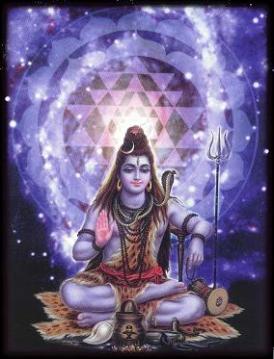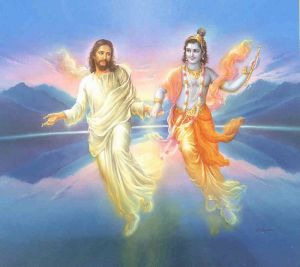If yoga is beyond religion, then hinduism is also beyond ‘religion’ as per the current rhetoric and has to be described differently. It is
more precise if we say Yoga is a ‘practical’ gift from hinduism that has universal application, instead of rushing to say ‘yoga is beyond religion’. I need to bring up this topic as the current trends in yoga and religion ask for clarity on this subject.
 It is a very healthy trend these days that more people are looking for spiritual knowledge and solution than just succumbing to the pressure from religious ‘cult beliefs’ and sentiments. This is forcing the clergy in every religion to be updated, lest they be outdated!
It is a very healthy trend these days that more people are looking for spiritual knowledge and solution than just succumbing to the pressure from religious ‘cult beliefs’ and sentiments. This is forcing the clergy in every religion to be updated, lest they be outdated!
Unfortunately, this is accompanied by another trend, a rather unhealthy one. This is the corruption of the spirit and understanding behind yoga and that of every religion. This is the result of ‘mental laziness’ that looks for simplistic ‘feel good’ factors than real answers.While there are more qualified people to deal with the problems of religion, I shall try here to clarify some fundamentals about yoga and it’s relevance in organized religion.
Yoga is described as ‘Tattwa darshana upayam’. This means ‘an aid for understanding reality’. Mind is an instrument. In sanskrit we call it ‘Antahkarana’ ; meaning ‘Inner Instrument’. Yoga can be seen as a practice tool that keeps this instrument in good shape. With the success in the practice of yoga, one develops what is called as ‘viveka kyati’ or simply ‘viveka’.
This viveka can be understood broadly as ‘A mind that is available for reality’.
Even before ‘viveka’ develops in our ‘budhi’ ( faculty of perception/understanding), we gain the capability of ‘making the mind available for a given task’. Simply put, this is the ability to do something without much distraction and inner pressure.
Now, that is something that everyone is looking for! hence the universal appeal of Yoga.
Having said this much, we are ready to explore the relevance of Yoga in organized religion. Let me start with some versions of hinduism.
Yoga for a ‘Hindu’:
Yogic principles are found in every aspect of every branch of hinduism. Even a simple everyday ritual includes some form of pranayama.
A advaitin uses yoga as a tool for purifying the mind and making it fit for contemplation and devotion to the God based on understanding of reality.
A person who follows a school opposed to await is usually a ‘vaishnavite’, ‘siddhantin’ or a ‘madhwa’. They use yoga as a tool for disciplining the lower nature and allowing the mind to focus on their ‘Ishta devata’, the chosen form of their Lord.
So, for a hindu, yoga is part of religion, may be a higher aspect of religion. At the advanced level, different groups in hinduism use yoga with different intentions.
For a Hindu, Yoga opens the way to heaven and enlightenment that is ‘more than heaven’, that is the Highest.
Yoga for other religions:
Leaders from religions other than ‘Hinduism’ seems to have a problem with the increasing popularity of ‘yoga’ and the natural consequence of ‘yoga leading to hinduism’. This is where the yoga teachers rush to a simplistic defensive reaction, by declaring yoga as being ‘secular’ and ‘beyond religion’.I can understand their business anxiety. At the same time, ‘thinking driven by fear’ does not befit a yogi.
We can find a simple solution by being conscious of the fact that yoga is a body of knowledge about the workings of the mind, vital body, their relation to physical body and the world around us; and a set of practices based on this knowledge. This knowledge is basically from the revelations of the veda, supplemented by detailed explanations by various sages and yogis (sruti and smrti). Without this body of knowledge,there is no yoga. This implies, there is no yoga without hinduism.
Even if you say that hinduism is only the rituals and culture, while this knowledge is ‘spirituality beyond religion’, then it was this ‘hindu’ way of life that preserved the teachings and practices of yoga for thousands of years, inspire of all the cultural onslaught. A yoga practitioner disowning hindusim is like a child disowning mother.
With this clarity, we can teach yoga to members of other religions without denying the ‘hindu’ base of yoga, at the same time without ‘converting’ them to hindus.
When we present yoga to members of other cultures and religions, we can use the following points for clarity and a culturally non-invasive approach.
▪ Yoga does not require a hindu fashion statement. wearing indian dress, a dot on the forehead or a turban is not part of yoga, though these cultural habits may have a yogic basis.
▪ Vegetarian diet is helpful for yoga and essential for serious practitioners. No religion is against people who are vegetarians for health or environmental reasons, so they will not be against yoga for this alone. Lacto-Vegetarianism in yoga does not challenge any religious belief of christianity or Islam.
▪ Worship of God is essential in Yoga, but this does not mean the ‘god’ has to be in a ‘Hindu’ version. Scriptures of yoga use the methods prescribed by the veda when relating to God. But, Connecting to ‘God’ through any method of prayer and surrender as given by any mystic tradition is compatible with yoga. Hence ‘mantra initiation’ or ‘shaktipat’ is not essential.
▪ Yoga is not about ‘psychic powers’ or ‘trance experiences’. Yoga is the process of developing a relationship with God, freedom from addiction to experiences, and the knowledge of one’s true nature.
▪ Practices of breath awareness and control are aimed at keeping our lower nature in check and making our mind available for any conscious task. Even ‘kundalini’ is for the same purpose of ‘freedom from habits and compulsions’.
▪ Different imagery used in yogic literature that come from Hinduism are only artistic and symbolic representation that reflect the above mentioned purpose of Yoga and are not to be taken literally. we can emphasize the meanings and leave the imagery that does not appeal to the members of other religions. We don’t have to deny hinduism for this reason.
Yoga for Christians :
Patanjali’s yoga sutra says (chapter-2, sutras 52 & 53)
“pranayama removes the covering of light and makes the mind fit for meditation”.
This is the purpose of pranayama. So the church need not be afraid of pranayama being ‘satanic’ and essentially ‘evil’ that gives one access to ‘dark forces’. In fact pranayama keeps the ‘dark forces’ away by giving us inner strength against temptation.
St. Francis of Assisi, in his exposition of the ‘Our father ‘ prayer, interprets “thy will be done on earth as it is in heaven” as, so that we may love Thee with our whole heart (cf. Lk 10:27) thinking of Thee always, with our whole soul desiring Thee always, with our whole mind directing unto Thee all our intentions, seeking Thy honor in all things and with all our strength expending our every strength and sense of soul and body in submission to Thy love and nothing else; and may we love our neighbors as ourselves drawing all to Thy love to the extent of our abilities, rejoicing over the good things of others just as over our own and compassionating them in evils and giving offense to no one (cf. 2 Cor 6:3).
Pranayama and the practice of ‘Iswara pranidhana’ helps a christian to “desiring Thee always, with our whole mind directing unto Thee all our intentions,”
About vegetarianism, It is very common among Eastern orthodox christians to maintain vegetarian diet during the month preceding christmas and Easter, for the purpose of purification. (In Romania it is my favorite period to enjoy eggless cakes and pastries which are almost impossible to get at other times!)
One can extend the same logic for entire life, in the name if the lord, son and the holy spirit, and yoga, to remain pure for praying ceaselessly!
Here I have given only two examples, to explain how practice of Yoga and meditation techniques can be helpful for ‘Christian Prayer’. I can point out numerous other examples. As I read about the practice of christian religion, in any version, I see a helpful role for yoga in almost every aspect of their religion, without having to succumb to the ‘sin’ of syncretism’ that the pope really dislikes.
Yoga will help a christian ‘attain heaven’ without need for much purgation.
Yoga for Muslims:
I have to admit that my knowledge of Islam is much lesser than my knowledge of christianity. But I often quote a traditional Islamic statement “Insha Allah” whenever I teach the concept of ‘Karma Yoga’. Insha Allah means ‘God willing’. Every muslim uses this expression even for the simplest of daily activities.
They say. “Insha Allah, we will meet tomorrow”.
I would quote here Ramana maharishi’s Upadesa Undiyaar, where his first verse is
“As the result of Karma ( action) is by the command of God, can ‘karma’ become God? No. Because, Karma is Inert by itself”
( translated from Tamil)
The essence of Karma yoga is recognizing the fact that results of our actions come from God, and not only from our effort. What we mean by God in this context may be philosophically different from classical mohammedan Islam, but the spirit behind it, the ‘Bhava’ , is the same.
Islam and ‘Iswara pranidhana’ mean the same thing in the level of practice.
Another simple benefit from yoga is to help a muslim pray 5 times a day without giving in to laziness. Of course their ‘namas’ ritual can be done with the added flexibility that comes as a result of yoga practice.
If I read the Quran, I am sure I can find a lot of opportunities for a muslim to use the acknowledge and practice of yoga in a way that is helpful in the practice of Islam.
For a muslim worrying about ‘many Gods’ in hinduism, I would like to point out that for many of us hindus who are advaitins, it is only many ways of relating to the same God, just like how we use different browsers for surfing the internet.
Wherever God comes in Yoga, a Muslim can substitute with Allah, and instead of Mantras, a Muslim can say his traditional prayers. It is perfectly compatible with yoga and will give the same benefits, again, without the ‘sin’ of ‘syncretism’ and sending the muslim to heaven by making him/her stronger in the faith.
Conclusion:
As I have treated the relevance of yoga for christians and muslims, I can include every other faith group in the world, be it the Yoruba of nigeria, Jews, Makumba, Shintoist, Taoist, Mormons, Newage, Atheists, Scientologists, Agnostics, or the Gnostics.” and show how yoga can be practiced without any socio cultural intrusion; that Yoga is Hindu in essence, with scope for universal application.
Yoga is based on the knowledge that everyone is fine in reality and only has to discover it with maturity. Hence, there is no pressure for a real yogi to ‘save’ souls and the world. This gives us the flexibility, freedom and grace to give the knowledge of yoga in a way that is appropriate for every individual, without encroaching their socio-cultural space.
May this article facilitate a sense of ease among the leaders of other religions regarding the practice of yoga by their followers. May this open them to discover the ‘right approach’ for the members of their faith to reap the full benefits of all aspects of yoga without having to ‘become a hindu’. May there be so much love of God in every Muslim and christian preacher that he or she shall see the futility of offensive Jihad and religious conversion.
May more christians go to church after practicing yoga, May every muslim yogi consider a moment of true prayer to Allah more worthy than all the wealth in the world. May every Hindu remain a better hindu by the knowledge and practice of Yoga and understand the true meaning of their scriptures. May every atheist understand the secrets of Reality. May every agnostic discover the true faith and knowledge. Om Shanti Shanti Shantihi!

 In the Hindu approach for tapping God’s grace, there is a concept of ’God with attributes – personal deity’ (saguna Brahmam – Ishta Devata). This feature is one of the most misunderstood by people of other religions and theologians. This feature makes hinduism appear as polytheistic or pagan. Let me try to explain in our everyday terms.
In the Hindu approach for tapping God’s grace, there is a concept of ’God with attributes – personal deity’ (saguna Brahmam – Ishta Devata). This feature is one of the most misunderstood by people of other religions and theologians. This feature makes hinduism appear as polytheistic or pagan. Let me try to explain in our everyday terms.

